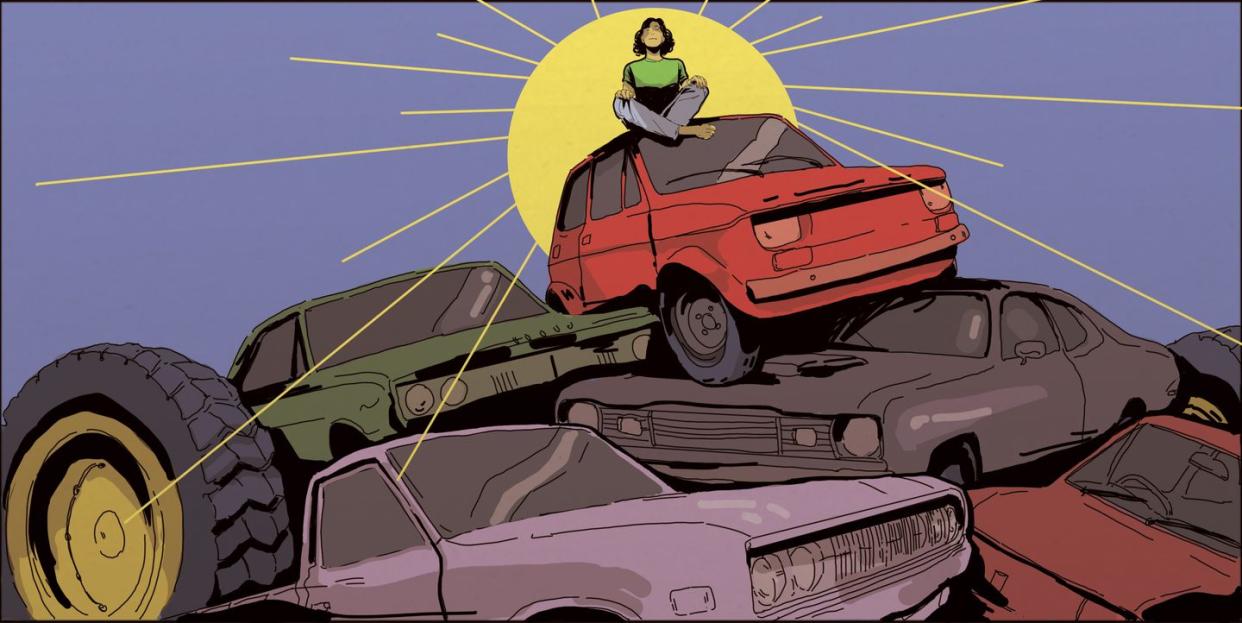Scherr: I Wish I Was Better at Selling Cars

From the October 2021 issue of Car and Driver.
I really should sell some vehicles. Have you seen the prices for used cars these days? And classics? Classic-car prices are up so high that half my conversations about cars end with me just nodding at people while they weep and point at a Bring a Trailer auction for a low-mileage '92 Viper at $161,161. According to the collector-car insurer Hagerty, values for vehicles in middling condition increased an average of more than 10 percent between May 2020 and May 2021. Better for sellers than buyers. For some reason, my helpful advice of "Have you tried wanting terrible cars that nobody else wants?" has not been greeted with enthusiasm by friends dead set on a trendy retro 4x4 or a sporty '90s Japanese hatch.
It's good advice, though. Terrible, unwanted cars are still very cheap. For example, and I say this with respect and a desire to own one, you could buy at least 20 Polski Fiat 126p coupes for the price of that Viper. Then you could run an all–Polski Fiat racing series, which would surely make you the fortune you need to buy all the Vipers or turbo Toyotas or vintage International Scouts you want.
People with less vision will say that's not how automotive investment works. They'll suggest buying low, selling at a profit, and using the proceeds to buy more desirable vehicles. Only, I have a terrible history on the sales side. The one car I attempted to flip was a 1967 Dodge Coronet 440. Dodge caused me some trouble by naming a trim level 440, which had no relation to my car's engine displacement, even though one of the brand's most popular mills at the time was a 440-cubic-inch big-block. This led to some consternation when I tried to sell it. After vacuuming all the mouse droppings from the engine bay, I spent a day at a car show saying "No, it's 318 cubic inches" to folks who read the 440 fender badge and wouldn't believe me when I said the small-block was original to the car. I finally sold it cheap to a guy just so he'd stop talking to me and go away. Later, I realized I'd left my ring, a gift from my grandparents, on the inner fender. The Coronet sale was not a financial win.
I didn't lose money when I sold my 1973 Plymouth Duster. I paid $3000 and sold it for $4500. But by the time we'd fixed the heater—the new owners were driving it home to Nova Scotia, and I couldn't send them back in a car with no heat—and put on a new vinyl top because it just looks better and, y'know, the Duster would be representing the U.S. in Canada, well, maybe I broke even on that one.
My last sale was a 1978 Datsun 620. Five-speed, long bed. It would be perfect for the mini-truck revival that's definitely just around the corner. I bought the Dat for $1000 and was selling it for $1000. Nobody on earth asks more annoying questions than a person shopping for a $1000 pickup. Can you haul a 250-gallon water tank and a pressure washer for your mobile detailing service in this 40-year-old truck that made 110 horsepower when it was new, weighs 2300 pounds, and has an 1100-pound payload? Um, sure. Should you? You aren't paying me enough to explain it to you.
My husband is also bad at selling things. He bought a dump truck as a parts donor for a different truck and ended up keeping it because he likes looking at it. To be fair, it is pretty awesome, like a full-size Tonka truck. We're very popular with visiting kids. He sold a crew-cab dually to someone who then wrecked it. He still talks about buying that one back and fixing it, even though we have a different, better crew-cab dually and (don't tell him I said this) we probably don't need two. If we had more land, I'd just keep everything and eventually be the subject of a Netflix show about car hoarding, but we're running out of parking spaces. Now is the right time to sell—and put the profits into that Polski Fiat racing plan.
You Might Also Like

